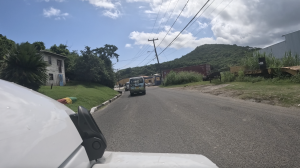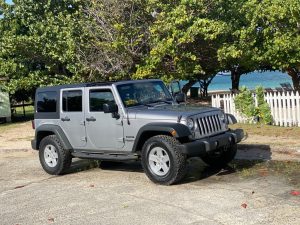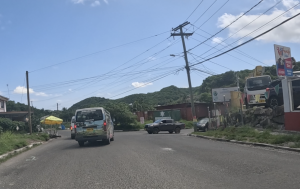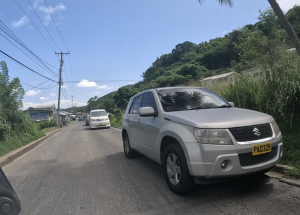Are you moving to Grenada soon and looking to bring a vehicle with you? Or, you might be a resident here and are looking to start learning to drive – regardless, there are a few different things you need to know about driving in Grenada, even if you’re only hitting the road as a tourist.
We’ve brought together a complete list of important bits and pieces worth knowing about motoring across the island so you don’t get caught out – and if there’s anything you’d like us to add or answer, just get in touch!
Don’t buy or drive a car in Grenada until you’ve read the following facts – let’s get stuck in.
1. You drive on the left in Grenada.
If you’re arriving in Grenada from somewhere like the United Kingdom, breathe easy – you won’t have to worry about switching sides of the road. Grenadian drivers take the left-hand side, which is typical for most other Caribbean countries.
It’s thought that the British history in Grenada led to the roads being designed this way – and it’s safe to say it’s stuck.

2. The roads can be narrow and winding!
Ask anyone about driving in Grenada, and they will likely tell you that many of the roads here are tight and hilly – meaning careful motoring is a must. Some of the island’s roads will also take you up high with little room for error – so don’t expect to run any races here!
That said, once you’re used to the roads here, traversing Grenada by car becomes second nature. Even tourists who only drive for a few days out of the year soon adapt to the road system (they’re just extra careful about it!). Driving in the main centres is highly predictable.
Do also keep an eye out for one-lane roads here. If you’re thinking of driving around in a muscle car or a people carrier, allow for some leeway!
3. There are wild hazards to be aware of.
If you’re accustomed to city driving, the wild island drives here in Grenada can seem a world or two away – especially when there’s risks of animals such as chickens, goats, and even pets likely to wander across.
However, you should also keep aware of landslides that can arise through heavy rainfall. For all the weather is usually amazing here, it can cause serious headaches for drivers. Bring some all-weather tyres just in case.

4. Be wary of low light conditions.
Many of the roads across Grenada are dimly lit – coupled with the tight and winding roads you’ll find largely in rural corners of the island, this can make motoring all the more dangerous.
Therefore, be aware that some hazards and road signs might not be so easy to spot after dark. The best advice we can give is to drive slowly and carefully until you know what to expect – provided you don’t keep too many people waiting!
5. You’ll need a temporary driving license in Grenada.
Depending on where you’re coming from, if you’re visiting Grenada and intend to drive, you’ll need to take up a temporary form of ID to prove you can safely handle the roads. If, again, say, you’re coming here from the UK, you’ll be able to approach a car hire company on the island with a valid British license and secure one for EC$60. Temporary licenses are valid for 3 months and are also issued by the police, the Royal Grenadian Police Force. Their Traffic Department headquarters can be found on Carenage Street in St. George’s.
6. Licensing requirements can vary depending on your hire company.
Tourists looking to obtain driving licenses in Grenada temporarily might need to provide an International Driving Permit, or IDP, which you will have to pay for before you travel. Some guides even claim that obtaining an IDP is necessary – and it certainly doesn’t hurt to apply for one.
In some cases, you might need to be older than a certain age, or even have a specific amount of experience behind the wheel. Requirements vary, so if this applies to you, compare different hire firms and see what fits.

7. You can apply for an IDP even after you arrive.
If you’re moving to Grenada from abroad or are staying for an extended period, you can still apply for your IDP after you’ve landed on Grenadian soil. However, it can take up to a month for it to fully process.
Therefore, if you’re willing to take public transport for a while after you land, you don’t necessarily need your IDP right away.
8. There are different age requirements for driving and renting in Grenada.
To drive a car in Grenada, you need to be at least 18 – meaning residents can start taking their lessons as they reach adulthood. However, if you want to rent a car out here, you’ll need to be at least 21.
And, yes – officials will check this information! If you’re planning to take a gap year out on the island, great – but make sure you celebrate your 21st before getting in touch with a hire firm.
9. Be aware of local drink driving limits.
You shouldn’t drink or take drugs at all before you’re due to drive – it’s just common sense – but keep in mind that the blood alcohol limit for driving in Grenada is 80mg per 100ml – similar rules to the UK.
Grenada is strict on these measures – so if you’re planning to have a drink or two in the evening, make sure you’re parked for the night, and if you need to get elsewhere, hire a taxi.

10. You can’t use your phone while driving.
Again – this law just makes sense, and it already applies elsewhere in the world! In Grenada, it’s illegal to use your phone while driving unless you have it connected hands-free.
So, make sure to invest in a bluetooth headset before you travel if you’re keen to keep in touch with friends and family on the road.
11. You’re likely to go off-road.
If you drive an offroader in any shape or form, you already have an advantage when it comes to travelling across Grenada. Many of the roads across the island are dirt tracks – or are simply unpaved – and it pays to be careful around potholes.
That said, these issues should only really cause concern if you’re driving around the more rural parts of Grenada – the tourist centers around the coastal areas tend to be well-maintained, so be ready for an off-road challenge if you’re heading inland at all.
It’s estimated that at least half of Grenada’s roads are fully paved.
12. Always wear your seatbelt.
Again, this really goes without saying – but you will fall foul of the law if you don’t wear seatbelts while driving in Grenada. That goes for everyone who’s in the vehicle with you, too.
Remember, this rule is less about making life difficult for motorists, and more about making sure everyone is safe – especially if you’re taking some of the more rural and rugged roads.
13. Insurance is a must!
It sounds like we’re treading over a few basic motoring rules here, but common sense yet again prevails in Grenada. If you intend to drive here for any length of time, you’re going to need some form of motor insurance, and you must be able to prove to authorities that you have valid certification.

14. There’s an age limit for hiring a car in Grenada.
One of Grenada’s most curious motoring laws relates to age limits and renting! Yes – believe it or not, if you’re over the age of 65, you won’t be permitted to hire a car on the island.
Therefore, if you’re planning to retire to the island, make sure to buy a car outright or to travel with someone younger than the rental limit.
15. It doesn’t take long to drive around the whole island.
If you drive around the entirety of Grenada, you’re likely to take a five-hour road trip. The island boasts two central roads connecting much of the country together, one from east to west along the coast, and another that connects Grenville and St. George’s.
16. You can rent cars from big brands in Grenada.
As a major tourist destination, it’s reasonable to expect there are plenty of car rental options in Grenada! In fact, you can set up a rental with the likes of Hertz and Avis before you arrive, or choose from one of the many local firms, including Sanvics Jeep and Car Rental, Dabs Car Rental. and Dove Luxury Car Rental.

17. It’s possible to import cars to Grenada, at a cost.
If you’d prefer not to invest in vehicles sold in Grenada itself, you can legally import cars into the country from overseas. You’re likely to spend a US equivalent of around $2,500 doing so – therefore, you’re going to need to make sure it’s the most economical choice for your motoring budget.
Keep in mind timescales, too. Apparently, it can take up to two months for some vehicles to be fully imported over to the Caribbean. In many cases, it’s faster and overall cheaper just to check out what’s available from lots and sellers actually on the island!
18. Speed cameras aren’t common, but you should still take care.
The speed limits set up across Grenada vary depending on different road factors – as you’d expect from elsewhere in the road – but the way limits are policed can be a different matter.
Grenada isn’t known for its fixed camera points and it’s rare that police will use handheld devices to monitor potential speeders. However, that doesn’t mean authorities will give you a free pass if you’re thundering down a dirt path!
In most cases, motoring police will evaluate suspected speeding on a case by case basis. The best thing to do is to stick to the limits of each road as they arise, and to drive with caution.

19. Fines can and will apply.
Grenada’s motoring police aren’t afraid to hand out fines where they feel a crime has been committed. These can occur on-the-spot – meaning you’ll need to pay fees at a given point by a certain date.
However, there are also cases where you might need to spend time temporarily in a cell, or even lose your license or car. Regardless of whether you are a citizen or a tourist, it pays to follow the road laws here.
20. Make sure you have full documentation to hand.
One of the best things you can do to support your case should you get pulled over by traffic police is to have all your ID and motoring documents handy.
Ideally, you should have some form of domestic license to hand (or your international coverage if you’re visiting from abroad), along with your proof of insurance and any registration documents referring to your car rental (if applicable).
It’s worth keeping these documents on side simply because you never know when police might need to see them – even if you strive to abide by traffic laws here!
21. You won’t need to worry about child restraints when it comes to the law.
Now, here’s where we really insist you apply common sense! Officially, there are no laws or regulations in Grenada yet to suggest how you should restrain children while you are driving. However, as any parent will agree, it’s always good practice to have seats fitted for babies and toddlers, and for any older children who need them.
If you’re renting a car while visiting Grenada, we also highly recommend you let any rental firms you book with know that you’re going to be travelling with children. The same will also apply to any additional insurance coverage you need to take out.
Use your common sense when it comes to travelling with kids!
Driving in Grenada can take some getting used to, but it’s an absolutely fabulous experience. There are no better spots in the Caribbean for road trips in paradise – and provided you adhere to local laws, you should have no trouble getting around.
Now you know a stack of facts about driving around Grenada, it’s time to find your next vehicle – take a look at our latest ads and find your next four-wheeled friend!
